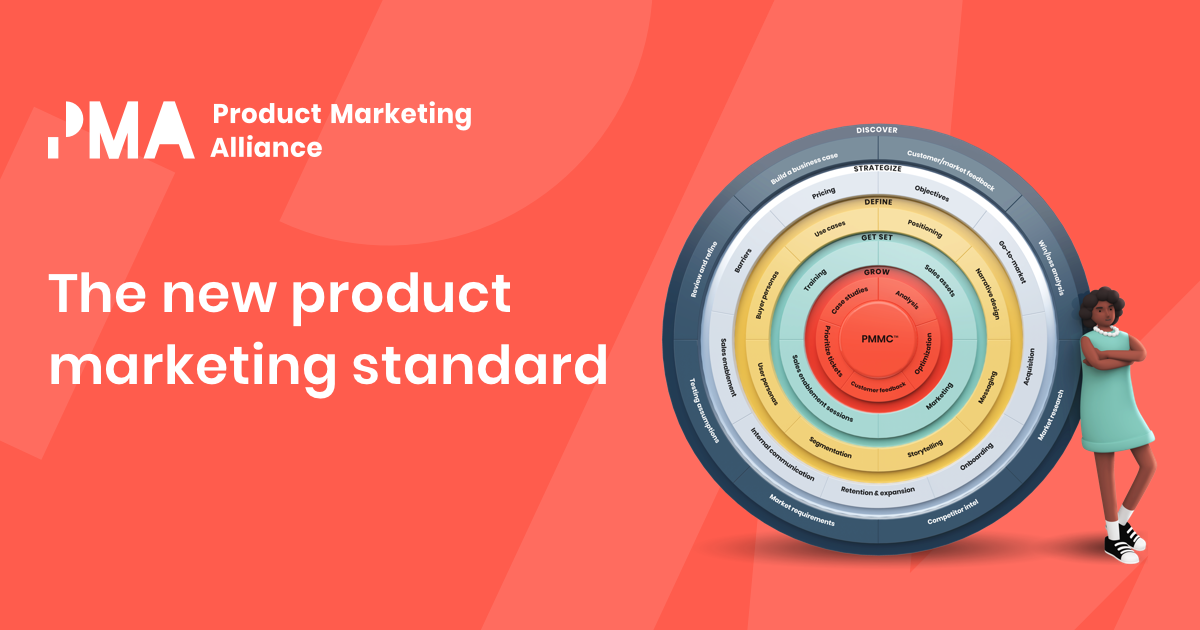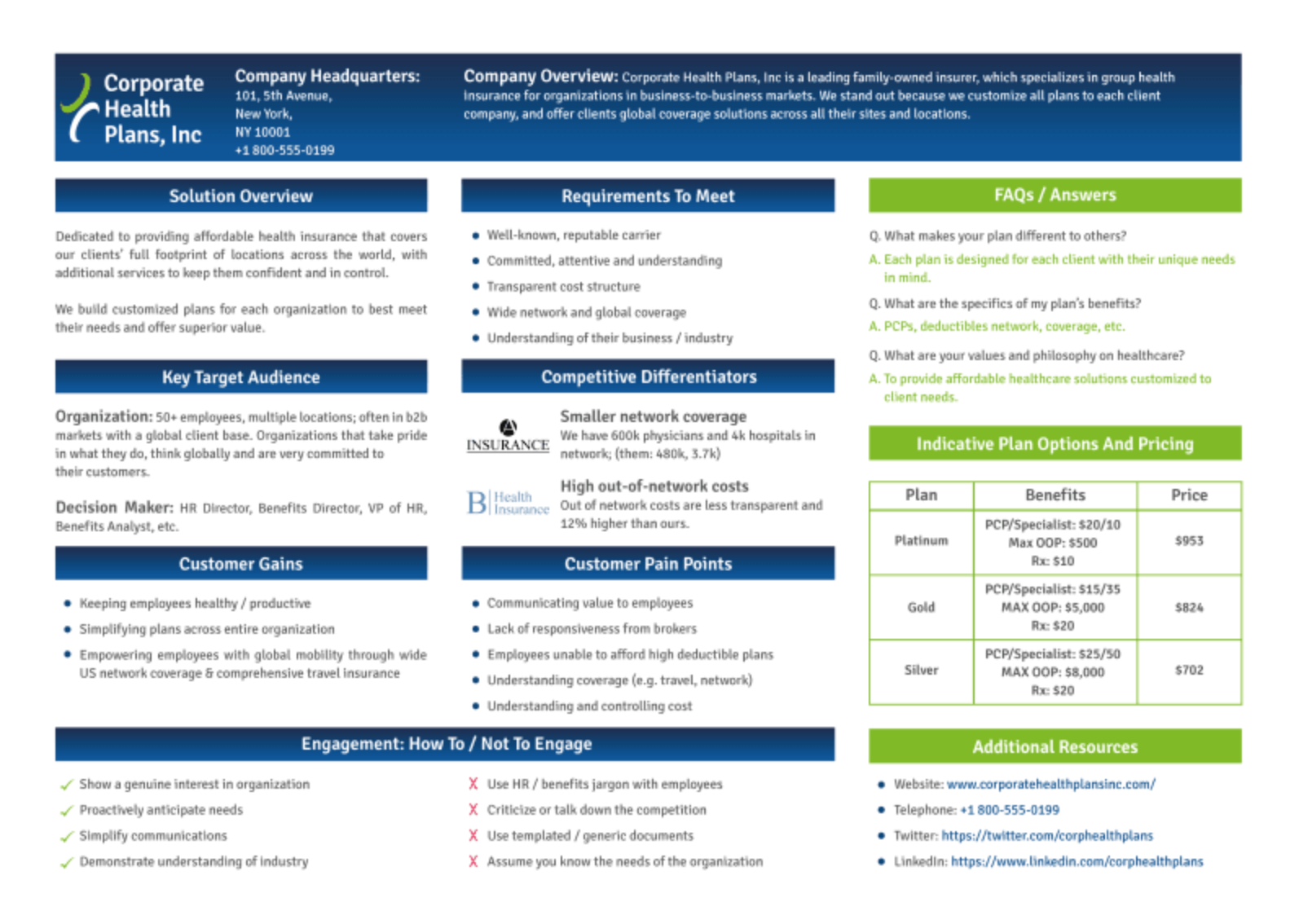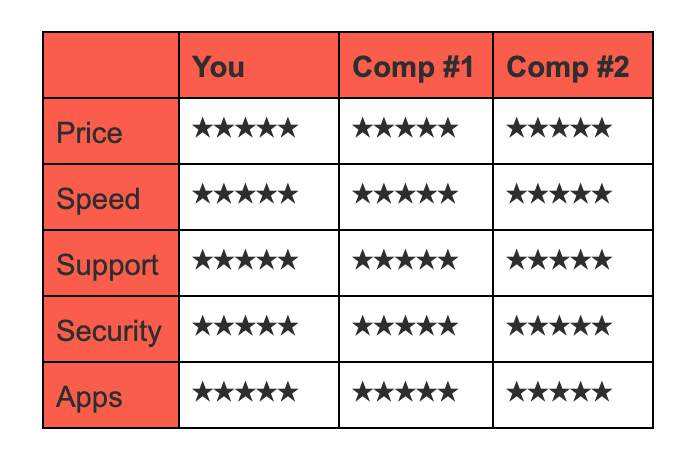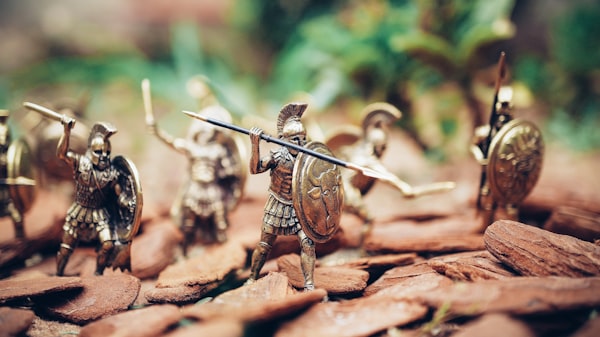Sales enablement assets help sales teams close more deals.
This can involve enrolling your team members in training courses to fine-tune their skills, or giving them access to third-party articles and videos.
Many companies include battlecards among these resources and provide these assets to their sales reps to turn their buyer personas into fully-fledged customers.
In this article, we'll focus on the essentials, such as:
- What is a battlecard?
- What to include in a battlecard
- Tips for creating battlecards
- Battlecard examples
- Why is sales enablement important?
- Sales enablement resources
- Battlecard templates and frameworks
What is a battlecard?
Battlecards are concise, actionable summaries of your product, the market, existing customers, and the competition, and their job is to equip your sales team with quick-fire responses to questions, queries, or objections a customer might have.
They also provide a firm understanding of a rival’s strategy and the value propositions needed to flag your offering as the preferable option.
Looking to create your own sales battlecard? We've got you covered - download our battlecard template 👇

What to include in a battlecard
Your battlecard should be specific to your product, and include sections focusing on:
- Company/product overview
- Customer pain points
- Key features
- Key differentiators
- Why your product or service is the best on the market
- A script to handle customer objections
- Questions to ask the prospect
- Pricing
- Third-party validation
- Refer to relevant customers
These features will help you create a thorough battlecard that’s relevant for your product. Let’s take a look at each feature in further detail:
Overview
The overview is a brief description of your company, your product, and what you're offering. Keep it punchy; 2-3 sentences is long enough.
Customer pain points
In this section, you need to address why people buy your product.
In the example below, the company sells health insurance to businesses. One of their customer pain points is that employees can't afford high deductible plans.

Key features
After identifying your customer’s pain points, you need to demonstrate how your product addresses them.
In the example above we looked at how most employees couldn't afford health insurance, and how this impacts their health and wellbeing.
In this section of the battlecard, not only would you highlight how you can successfully help your customer address any health concerns, but you’d also point out how offering employees your health care plan would ensure a healthier and more productive workforce.
Key differentiators
This is where you match your product up against your competitors.
For example, if you’re offering a software solution, is your product more speedy? Does it have more features? Is your customer support better?
A handy grid format will help your sales team answer these questions quickly and confidently. 👇

Why do you win?
In this section, you’ll need to know what’s important to your potential customers.
For example, is it the price? Customer service? Security? If you don’t know this information already, conduct some customer and market research to give you a thorough understanding of your customers and what their needs are.
List the relevant benefits your product provides and back it up with specifics. Use statistics, numbers, and real-life success stories.
Handling objections
Sometimes your sales team will face objections when pitching your product. You need to help them respond constructively and keep their pitch on track.
In this section, list your top three or four objections and script a response your sales team can refer to when they're met with these common obstacles.

Questions to ask
Here, list two or three questions your reps can ask the prospective customer to best position your product.
For example: “how do you feel about your current solution?” is a good starting point. This question allows your sales reps to differentiate your product from the competitors’.
Then, follow up with: “what’s the most frustrating thing about your current solution?” This question gives your reps insight into the prospect’s pain points and enables them to effectively position your product as the solution.
Pricing
Product pricing will always play a crucial role in your customers' final buying decisions.
Ashley Murphy, Toast's Director of Market Insights and Pricing, shared her specialist insights, including her preferred pricing strategy, the role of product marketing in the pricing process, and her own top tips.

Your battlecard must include a section outlining your pricing, and how you match up against your main competitors. Make sure your sales reps have everything at their disposal to answer any questions about pricing accurately and confidently.
Tip: Conducting competitive intelligence will help you keep an eye on your competitors’ pricing and update your content, so your sales reps don’t provide out-of-date information.

Quick tips
Here’s where you need to make a few short notes about how your sales rep can get the most out of the call.
For example, it may be necessary to list a couple of questions you’d like your rep to ask, such as: “Ask how many contacts they have” or “Find out what their current solution is early on.”
Third-party validation
Reputable customer testimonials or endorsements are priceless; they can give your product credibility and provide insight into what the prospect can expect if they decide to invest in your solution.
This section needs to shine the spotlight on what great things your existing customers are saying about you.
If a well-established, internationally recognized brand has provided a review, use their quotes. This could include a comment a customer made about how much quicker they completed a task with your solution, in comparison to one of your competitors’ products.
Refer to relevant customers
Give your prospective customer FOMO by reeling off the companies you already have as customers. However, be sure to keep it relevant.
For example, an SME will be more likely to relate to another SME over a Fortune 500 company.
Tips for creating battlecards
When planned and executed correctly, a battlecard can play a significant role in your sales success.
With this in mind, we asked product marketers for their tips on creating effective battlecards, and how they use them in their respective companies.
“I like to start with a SWOT for each competitor. I try honestly to assess their strengths, weaknesses, etc. I keep it pretty simple but I find it is a great starting point before building a battlecard.”
Martin Bakal, Product Marketing Director and Evangelist at OpenLegacy
“Firstly, consider your audience. How can you amplify the value of your research to cover not just sales processes, but product and leadership strategy?
“You also need to include impacts to your go-to-market strategy and predictions for their future go-to-market strategy, customer segmentation, and product.
“Get in the weeds with pricing, packaging, and value delivery. Don’t just look at the perfect price point, but consider the value from your target customer’s perspective.
“Finally, include quotes where possible, and feedback from a customer that a) chose a competitor over you, and b) chose you over a competitor.”
Fiona Finn, Director of Product Marketing at Unbounce
“Communicate internally and survey your sales team to understand who they're actually competing against and also pull in win/loss analysis to enhance your battlecard.
“Also, spell out how your company wins against each competitor so it's easy for sales to get what they need quickly.”
Jaclyn Rose, Staff Product Marketing Manager at HealthJoy
Why is sales enablement important?
You may be skeptical as to whether you need to create battlecards and accompanying sales enablement resources, especially if your sales figures are through the roof.
But ask yourself the following questions:
- Are you hitting ALL of your sales goals?
- Are your reps always on message?
- Are you 100% sure reps are using sales tools to their full potential?
- Can you improve seller quota attainment?
If you’ve answered NO to any of these questions, or if you know there’s room for improvement, you need to devote time and effort to strengthening your sales enablement tools.
Even if you answer every question with a resounding YES, your business fortunes can quickly change.
For example, if you recruit new team members, you may need to formalize your onboarding process. Perhaps your reps have been tasked with selling an ever-changing product or service, in which case, the buying process could become more complicated, or your product messaging or go-to-market strategy may have to be revamped.
Having the appropriate sales enablement tools in place can work wonders for companies keen to maintain sales figures during a transition period.
Still not 100% convinced? Complete a sales enablement scorecard to establish how strong your current setup is.
Sales enablement resources
Battlecards are one of many types of sales enablement assets you can use in your teams.
Below are some resources to help you explore sales enablement further.
(We also focus on the topic in our State of Product Marketing Report 2020)
- 22 sales enablement tools for product marketers
- Sales enablement scorecard
- So true! 7 ways comedy can impact sales enablement and prospecting
- Simple strategies to cut through the noise and engage sales
- Scaling sales enablement: a product marketing perspective
- How to deliver an effective product demo
- How to create a first-class product comparison page
- How to create product collateral
Battlecard templates and frameworks
If you’re a PMA member, we’ve created a bank of editable templates and frameworks to help your sales team convert leads into customers.
Not a member already? Sign-up for a PMA membership to get access, and enroll in our Product Marketing: Core [On Demand] course, or Product Marketing: Core [Live + Online] accreditation to level up your strategy.


















 Follow us on LinkedIn
Follow us on LinkedIn





.svg?v=8154f0fdee)